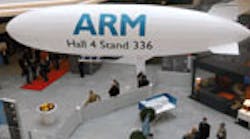Identifying industry trends at major electronics shows is never easy, and it wasn’t simple in Nuremberg at Embedded World. Nearly 830 companies attended, and there was plenty of corporate jostling in an attempt to grab a slice of the limelight for their new technologies and products.
But if one company rose above the fray in this attention-grabbing frenzy, it was ARM. During the show, nearly half of the announcements we saw were linked to developments made possible by ARM processors
From An Acorn
It’s hard to think that the ARM story started back in 1983 with the newly developed Acorn Computers and its BBC Micro Computers, which were the PC of choice for schools in the U.K. Even harder to grasp since their humble beginnings in a basic computer is how ARM processors now account for just over 90% of all embedded 32-bit RISC processors. In fact, each of the more than 1 billion mobile phones sold each year uses at least one ARM processor. Their simple design makes them the right choice for low-power apps
Back in the 1980s, Acorn Computers achieved considerable success with its BBC Micro Computers but needed to move forward into the business sector. It considered adopting a MOS-based processor, and in doing so it fell into the pattern being set by the IBM PCs. However, processors around at that time from the likes of Motorola and National Semiconductor weren’t really what Acorn wanted, and that situation created the environment that would eventually give birth to ARM.
ARM Is Born
VLSI Technology partnered with Acorn, and their development work spun a new company out of the partnership—Advanced RISC Machines Ltd., which quickly became ARM. It was floated on the London Stock Exchange in the late 1990s
The basic design concept with ARM was simplicity linked to power economy, and ARM2 was exemplary in following this concept. As a 32-bit microprocessor, it had 30,000 transistors. The Motorola 68000 processor had, of course, 68,000. The lack of microcode and cache were key elements of the simple ARM design. The result was a low-power device that expert opinion at the time said outperformed the Intel 80286. A successor to ARM2, ARM3, was produced with a 4-kbyte cache that further improved performance.
ARM At The Show
Not surprisingly given the technical achievements of ARM, the keynote speech at Embedded World in Nuremberg was presented by ARM CTO Mike Muller. Even less surprisingly, the presentation was entitled “Low-Power Embedded Design—What Next?”
Muller described many of the challenges facing designers working with embedded systems. He also discussed how the mobile phone industry in particular has influenced the hardware and software value chain as well as the ramifications of this influence on low-power embedded design.
In addition to providing insight into the next generation of low-power, high-performance embedded devices and enabling greater use of the Internet, ARM hosted classes at the show, giving visitors insight into designing with ARM processors.
Show Announcements
Which companies announced developments relative to ARM during the show? Toshiba revealed a free PC software package that speeds and simplifies the development, prototyping, and testing of embedded motion control applications built around ARM Cortex-M3 motor control microcontrollers.
Silicon Laboratories unveiled its Precision32 MCU family, which is based on the ARM Cortex-M3 processor. The lineup includes 32 SiM3U1xx and SiM3C1xx MCU products with footprint-compatible USB and non-USB options.
NXP released what it calls the world’s first dual-supply voltage ARM Cortex-M0 Microcontrollers. The company’s LPC1100LV series offers 50 MIPS performance in a 2- by 2-mm footprint that reduces power by more than a factor of three compared to similar 3.3-V VDD devices, says NXP.
Kontron showed an ARM-based Pico-ITX embedded motherboard with a dual-core ARM Cortex A9. Also, distribution company RS Components launched a range of ARM-based development boards supporting the processor firm’s Mbed modular design platform.
Infineon combined its knowledge of microcontroller design for real-time critical control applications to create the XMC4000 microcontroller family based on the ARM Cortex-M4. Meanwhile, Atmel unveiled its Studio 6 integrated development environment (IDE), which now supports both Atmel 32-bit ARM Cortex-M series processor-based and Atmel 8/32-bit AVR-based microcontrollers.
Freescale debuted an embedded board solutions initiative. It is working with its board vendors to broaden the availability of its processors based on Power Architecture and ARM technologies in standardised, off-the-shelf, system-on-module form factors.
So the omnipotent ARM technology was a huge factor at Embedded World. Because of its influence, it’s easy to understand how out of all the major electronics shows, this one has earned the reputation as the show of choice for electronics engineers.

